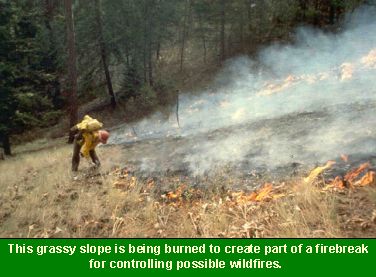7. Fire Management - continued
Wildfire and prescribed fire change erosion rates on the burned area in two ways. First, fire eliminates vegetative soil cover. Second, chemical changes in the soil following fire create an increased resistance to water infiltration in the upper soil layer, and this increases surface runoff and sheet erosion. The magnitude of these effects depends on how hot a fire burns, and this in turn depends on numerous site characteristics. Erosion following fire is most severe where a fire has burned most intensely and the fire is followed by a strong storm, a year of moderately high rainfall, or a spring with a large volume of snowmelt. Wildfire control practices helpful to water quality include:
- Whenever possible avoid using fire-retardant chemicals in SMZs and over watercourses, and prevent their runoff into watercourses. Do not clean application equipment in watercourses or locations that drain into watercourses.
- Close water wells excavated for wildfire-suppression activities as soon as practical following fire control.
- During wildfire emergencies, firelines, road construction, and stream crossings are unrestricted by BMPs. However, install BMPs and begin remediation as soon as possible after the emergency is controlled.
![[logo] US EPA](https://www.epa.gov/epafiles/images/logo_epaseal.gif)
